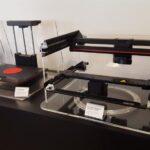

Probably one of the few promising new technologies which can arouse a crowd as easily as 3D printing can, would be driverless cars. We all have heard by now that Google and various car manufacturers are working on technology, which one day very soon, will allow us to sit back and relax as our cars drive us around, totally unassisted.
There are many benefits to driverless cars. Americans spend an average of 120-150 minutes each day in their vehicles. Imagine what we could be doing with that time, if we didn’t have to pay attention to the road. Some of us may play games or watch the next episode of ‘Breaking Bad’ on Netflix, while others will get a little extra work done so that they can spend more time with their families when they get home. That’s not the main benefit, however. It is estimated that driverless vehicles will cut down on traffic fatalities by as many as 30,000 a year, in the United States alone. That’s 80 deaths avoided each and every day!
MakerBot CEO and cofounder Bre Pettis, yesterday gave a 45 minute open interview at the Northside Festival in Brooklyn. In the interview he discussed all sorts of technologies, mainly 3D printing of course. In the entire 45 minutes, he made one remark which really stuck with many in the audience.

Yes, driverless cars promise to change our lives for the better, as well as save them, but there is one aspect of the life saving attributes of the technology, which may lead to problems, albeit problems we are happy to be dealt. If fatalities from motor vehicle accidents all but stop, there will be a huge organ donor supply constraint, as most organs which are donated come from accident victims. If there are no accident victims, we will need to find an alternate supply of healthy organs for transplant patients. I will stop you right here, Pettis did not suggest an organized organ theft ring. What he did suggest is that driverless car technology will spur on massive innovation within the bioprinting space.
There are already several companies around the world working on 3D printing human tissue, with an ultimate goal of bioprinting functioning human organs, like the heart, liver, and kidneys. As the supply curve shifts to the left, the price willing to be paid for such organs will increase substantially. As major biotech firms realize this, they will begin pumping millions, if not billions of dollars into the field of bioprinting.
The world is changing, technology always seems to keep up with the problems we face. Will driverless cars lead to innovation within the bioprinting space? Let us know your opinion in the bioprinting forum thread at 3DPB.com
If you're looking to get architectural 3D animation in the USA, our service provides an exceptional way to bring your architectural concepts to life through dynamic, immersive visuals. Through our platform, you can easily request high-quality 3D animations that showcase your designs in motion, offering a detailed view of your project from multiple angles and perspectives. Whether it's for a real estate development, a commercial building, or an urban planning project, our expert team ensures that every detail is captured in a visually compelling animation.
Through our website, you can seamlessly get architectural 3D animation tailored to your project’s specific needs. With our help, you can offer potential clients or investors an engaging experience that goes beyond static images. By integrating CGI animations with real-world settings, lighting, and textures, our team creates a lifelike experience that allows your audience to interact with your project as though it were already built. This service is perfect for presenting complex designs in a clear, visually attractive way that stands out in the competitive architectural market.




